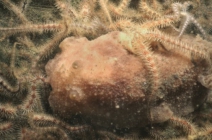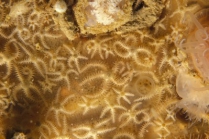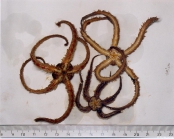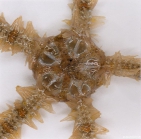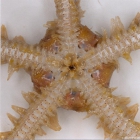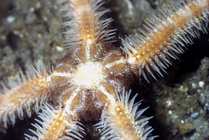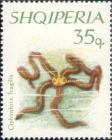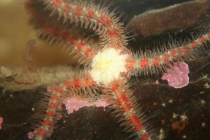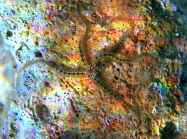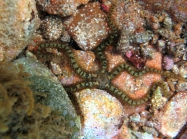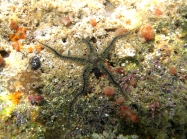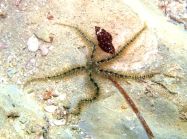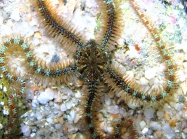WoRMS taxon details
Ophiothrix Müller & Troschel, 1840
123626 (urn:lsid:marinespecies.org:taxname:123626)
accepted
Genus
Ophiocoma rosula Forbes, 1839 accepted as Ophiothrix fragilis (Abildgaard in O.F. Müller, 1789) (type by subsequent designation)
Ophionyx Müller & Troschel, 1840 · unaccepted (synonym)
- Subgenus Ophiothrix (Acanthophiothrix) A.M. Clark, 1967
- Species Ophiothrix (Acanthophiothrix) armata Koehler, 1905
- Species Ophiothrix (Acanthophiothrix) deceptor Koehler, 1922
- Species Ophiothrix (Acanthophiothrix) diligens Koehler, 1898
- Species Ophiothrix (Acanthophiothrix) exhibita Koehler, 1905
- Species Ophiothrix (Acanthophiothrix) lepidus de Loriol, 1893
- Species Ophiothrix (Acanthophiothrix) leucotrigonia H.L. Clark, 1918
- Species Ophiothrix (Acanthophiothrix) proteus Koehler, 1905
- Species Ophiothrix (Acanthophiothrix) purpurea von Martens, 1867
- Species Ophiothrix (Acanthophiothrix) scorpio (Müller & Troschel, 1842)
- Species Ophiothrix (Acanthophiothrix) scotiosa Murakami, 1943
- Species Ophiothrix (Acanthophiothrix) signata Koehler, 1922
- Species Ophiothrix (Acanthophiothrix) spinosissima Koehler, 1905
- Species Ophiothrix (Acanthophiothrix) suensonii Lütken, 1856
- Species Ophiothrix (Acanthophiothrix) versatilis Koehler, 1930
- Species Ophiothrix (Acanthophiothrix) vetusta Koehler, 1930
- Species Ophiothrix (Acanthophiothrix) vexator Koehler, 1930
- Species Ophiothrix (Acanthophiothrix) vigelandi A.M. Clark, 1968
- Species Ophiothrix (Acanthophiothrix) viridialba von Martens, 1867
- Species Ophiothrix (Acanthophiothrix) picteti de Loriol, 1893 accepted as Ophiothrix (Ophiothrix) picteti de Loriol, 1893
- Subgenus Ophiothrix (Ophiothrix) Müller & Troschel, 1840
- Species Ophiothrix (Ophiothrix) accedens Koehler, 1930
- Species Ophiothrix (Ophiothrix) ailsae Tommasi, 1970
- Species Ophiothrix (Ophiothrix) angulata (Say, 1825)
- Species Ophiothrix (Ophiothrix) aristulata Lyman, 1879
- Species Ophiothrix (Ophiothrix) caespitosa Lyman, 1879
- Species Ophiothrix (Ophiothrix) ciliaris (Lamarck, 1816)
- Species Ophiothrix (Ophiothrix) consecrata Koehler, 1930
- Species Ophiothrix (Ophiothrix) contenta Koehler, 1930
- Species Ophiothrix (Ophiothrix) crassispina Koehler, 1904
- Species Ophiothrix (Ophiothrix) deposita Koehler, 1904
- Species Ophiothrix (Ophiothrix) dyscrita Clark, 1915
- Species Ophiothrix (Ophiothrix) echinotecta Balinsky, 1957
- Species Ophiothrix (Ophiothrix) elegans Lütken, 1869
- Species Ophiothrix (Ophiothrix) exigua Lyman, 1874
- Species Ophiothrix (Ophiothrix) foveolata Marktanner-Turneretscher, 1887
- Species Ophiothrix (Ophiothrix) infirma Koehler, 1905
- Species Ophiothrix (Ophiothrix) koreana Duncan, 1879
- Species Ophiothrix (Ophiothrix) leucospida Koehler, 1930
- Species Ophiothrix (Ophiothrix) liodisca H.L. Clark, 1915
- Species Ophiothrix (Ophiothrix) miles Koehler, 1905
- Species Ophiothrix (Ophiothrix) oerstedii Lütken, 1856
- Species Ophiothrix (Ophiothrix) panchyendyta Clark, 1911
- Species Ophiothrix (Ophiothrix) pavida Koehler, 1922
- Species Ophiothrix (Ophiothrix) picteti de Loriol, 1893
- Species Ophiothrix (Ophiothrix) plana Lyman, 1874
- Species Ophiothrix (Ophiothrix) prostrata Koehler, 1922
- Species Ophiothrix (Ophiothrix) roseocoerulans Grube, 1868
- Species Ophiothrix (Ophiothrix) rotata von Martens, 1870
- Species Ophiothrix (Ophiothrix) rudis Lyman, 1874
- Species Ophiothrix (Ophiothrix) savignyi (Müller & Troschel, 1842)
- Species Ophiothrix (Ophiothrix) spiculata Le Conte, 1851
- Species Ophiothrix (Ophiothrix) tradita Koehler, 1930
- Species Ophiothrix (Ophiothrix) tricuspida Cherbonnier & Guille, 1978
- Species Ophiothrix (Ophiothrix) trilineata Lütken, 1869
- Species Ophiothrix (Ophiothrix) trindadensis Tommasi, 1970
- Species Ophiothrix (Ophiothrix) vitrea Döderlein, 1896
- Species Ophiothrix (Ophiothrix) alboviridis (Brock, 1888) accepted as Ophiocentrus alboviridis (Brock, 1888) (erroneously transferred to Ophiothrix)
- Species Ophiothrix (Ophiothrix) marenzelleri Koehler, 1904 accepted as Ophiothrix (Ophiothrix) exigua Lyman, 1874
- Species Ophiothrix (Ophiothrix) megaloplax Koehler, 1930 accepted as Ophiothrix (Ophiothrix) aristulata Lyman, 1879
- Species Ophiothrix (Ophiothrix) oliveri Benham, 1911 accepted as Macrophiothrix oliveri (Benham, 1911) (transferred to Macrophiothrix by Mills & O'Hara (2013))
- Subgenus Ophiothrix (Theophrix)
- Species Ophiothrix amphibola H.L. Clark, 1939
- Species Ophiothrix berberis Lyman, 1879
- Species Ophiothrix brachyactis H.L. Clark, 1915
- Species Ophiothrix brasiliensis Santana, Manso, Almeida & Alves, 2020
- Species Ophiothrix cimar Hendler, 2005
- Species Ophiothrix comata Müller & Troschel, 1842
- Species Ophiothrix congensis Koehler, 1911
- Species Ophiothrix convoluta Koehler, 1914
- Species Ophiothrix cotteaui (de Loriol, 1900)
- Species Ophiothrix dedita Koehler, 1930
- Species Ophiothrix dirrhabdota H.L. Clark, 1918
- Species Ophiothrix eurycolpodes H.L. Clark, 1918
- Species Ophiothrix fragilis (Abildgaard in O.F. Müller, 1789)
- Species Ophiothrix galapagensis Lütken & Mortensen, 1899
- Species Ophiothrix hartfordi A.H. Clark, 1939
- Species Ophiothrix innocens Koehler, 1898
- Species Ophiothrix lineata Lyman, 1860
- Species Ophiothrix luetkeni Wyville Thomson, 1873
- Species Ophiothrix maculata Ljungman, 1872
- Species Ophiothrix magnifica Lyman, 1860
- Species Ophiothrix marginata Koehler, 1905
- Species Ophiothrix merguiensis Duncan, 1887
- Species Ophiothrix nociva Koehler, 1907
- Species Ophiothrix pallida Ljungman, 1872
- Species Ophiothrix parasita Müller & Troschel, 1844
- Species Ophiothrix petersi Studer, 1882
- Species Ophiothrix planulatus Stimpson, 1855
- Species Ophiothrix platyactis H.L. Clark, 1939
- Species Ophiothrix quinquemaculata (Delle Chiaje, 1828)
- Species Ophiothrix rathbuni Ludwig, 1882
- Species Ophiothrix simplex Koehler, 1905
- Species Ophiothrix spiniformis Santana, Manso, Almeida & Alves, 2020
- Species Ophiothrix stri Hendler, 2005
- Species Ophiothrix synoecina Schoppe, 1996
- Species Ophiothrix tenuis Koehler, 1905
- Species Ophiothrix tommasii Santana, Manso, Almeida & Alves, 2020
- Species Ophiothrix troscheli Santana, Manso, Almeida & Alves, 2020
- Species Ophiothrix variegata Duncan, 1887
- Species Ophiothrix viator Koehler, 1904
- Subgenus Ophiothrix (Keystonea) A.M. Clark, 1967 accepted as Macrophiothrix H.L. Clark, 1938 (synonym)
- Species Ophiothrix (Keystonea) hymenacantha H.L. Clark, 1928 accepted as Macrophiothrix hymenacantha (H.L. Clark, 1928) (synonym)
- Species Ophiothrix (Keystonea) irregularis (H. L. Clark, 1938) accepted as Macrophiothrix martensi (Lyman, 1874)
- Species Ophiothrix (Keystonea) martensi Lyman, 1874 accepted as Macrophiothrix martensi (Lyman, 1874) (synonym)
- Species Ophiothrix (Keystonea) nereidina (Lamarck, 1816) accepted as Macrophiothrix nereidina (Lamarck, 1816) (synonym)
- Species Ophiothrix (Keystonea) propinqua Lyman, 1861 accepted as Macrophiothrix propinqua (Lyman, 1861)
- Species Ophiothrix (Keystonea) pulchra (H.L. Clark, 1938) accepted as Macrophiothrix pulchra (H.L. Clark, 1938) (synonym)
- Species Ophiothrix (Keystonea) smaragdina Studer, 1882 accepted as Macrophiothrix smaragdina (Studer, 1882) (synonym)
- Species Ophiothrix (Keystonea) vicina Koehler, 1930 accepted as Macrophiothrix vicina (Koehler, 1930) (synonym)
- Subgenus Ophiothrix (Ophiothela) accepted as Ophiothela Verrill, 1867
- Species Ophiothrix (Ophiothela) mirabilis Verrill, 1867 accepted as Ophiothela mirabilis (Verrill, 1867)
- Subgenus Ophiothrix (Placophiothrix) H.L. Clark, 1938 accepted as Macrophiothrix H.L. Clark, 1938 (synonymized with Macrophiothrix)
- Species Ophiothrix (Placophiothrix) albolineata (Clark, 1938) accepted as Macrophiothrix albolineata (H.L. Clark, 1938) (synonym)
- Species Ophiothrix (Placophiothrix) albostriata Clark, 1928 accepted as Macrophiothrix albostriata (H.L. Clark, 1928) (synonym)
- Species Ophiothrix (Placophiothrix) encarsia H.L. Clark, 1939 accepted as Macrophiothrix encarsia (H.L. Clark, 1939) (synonym)
- Species Ophiothrix (Placophiothrix) hybrida H.L. Clark, 1915 accepted as Macrophiothrix hybrida (H.L. Clark, 1915)
- Species Ophiothrix (Placophiothrix) lineocaerulea H.L. Clark, 1928 accepted as Macrophiothrix lineocaerulea (H.L. Clark, 1928) (invalid subgenus)
- Species Ophiothrix (Placophiothrix) melanosticta Grube, 1868 accepted as Macrophiothrix melanosticta (Grube, 1868) (unaccepted > superseded combination, invalid subgenus)
- Species Ophiothrix (Placophiothrix) spongicola Stimpson, 1855 accepted as Macrophiothrix spongicola (Stimpson, 1855) (unaccepted > superseded combination, invalid subgenus)
- Species Ophiothrix (Placophiothrix) striolata Grube, 1868 accepted as Macrophiothrix striolata (Grube, 1868) (synonym)
- Species Ophiothrix (Placophiothrix) virgata Lyman, 1861 accepted as Macrophiothrix virgata (Lyman, 1861) (synonym)
- Species Ophiothrix (Placophiothrix) westwardi Devaney, 1974 accepted as Macrophiothrix propinqua (Lyman, 1861)
- Species Ophiothrix abstinens Koehler, 1930 accepted as Ophiothrix (Ophiothrix) panchyendyta Clark, 1911
- Species Ophiothrix abstineus Koehler, 1930 accepted as Ophiothrix (Ophiothrix) panchyendyta Clark, 1911
- Species Ophiothrix acestra H.L. Clark, 1909 accepted as Ophiothrix (Ophiothrix) ciliaris (Lamarck, 1816)
- Species Ophiothrix alba Grube, 1857 accepted as Ophiothrix fragilis (Abildgaard in O.F. Müller, 1789) (synonym acc. to H.L. Clark (1915))
- Species Ophiothrix albostriata H.L. Clark, 1928 accepted as Macrophiothrix albostriata (H.L. Clark, 1928) (synonym)
- Species Ophiothrix alopecurus Müller & Troschel, 1842 accepted as Ophiothrix fragilis (Abildgaard in O.F. Müller, 1789) (synonym)
- Species Ophiothrix andersoni Duncan, 1887 accepted as Macrophiothrix nereidina (Lamarck, 1816) (synonym)
- Species Ophiothrix aspidota Müller & Troschel, 1842 accepted as Macrophiothrix aspidota (Müller & Troschel, 1842)
- Species Ophiothrix beata Koehler, 1907 accepted as Ophiothrix (Ophiothrix) savignyi (Müller & Troschel, 1842) (synonymized by Mortensen (1926))
- Species Ophiothrix bedoti de Loriol, 1893 accepted as Macrophiothrix propinqua (Lyman, 1861)
- Species Ophiothrix bellax Koehler, 1922 accepted as Macrophiothrix bellax (Koehler, 1922)
- Species Ophiothrix belli Döderlein, 1896 accepted as Macrophiothrix belli (Döderlein, 1896)
- Species Ophiothrix capensis Lütken, 1869 accepted as Ophiogymna capensis (Lütken, 1869)
- Species Ophiothrix capillaris Lyman, 1879 accepted as Macrophiothrix capillaris (Lyman, 1879)
- Species Ophiothrix caribaea Lütken, 1856 accepted as Ophiothrix (Ophiothrix) angulata (Say, 1825) (synonymised by Verrill (1899))
- Species Ophiothrix carinata von Martens, 1870 accepted as Ophiothrix (Ophiothrix) ciliaris (Lamarck, 1816)
- Species Ophiothrix cataphracta Martens, 1870 accepted as Macrophiothrix nereidina (Lamarck, 1816) (synonym)
- Species Ophiothrix cheneyi Lyman, 1861 accepted as Macrophiothrix hirsuta cheneyi (Lyman, 1861)
- Species Ophiothrix ciliaris Müller & Troschel, 1842 accepted as Ophiothrix (Ophiothrix) ciliaris (Lamarck, 1816) (homonym, based on Lamarck's species)
- Species Ophiothrix clarescens Koehler, 1904 accepted as Ophiogymna clarescens (Koehler, 1904)
- Species Ophiothrix clypeata Ljungman, 1866 accepted as Ophiocnemis marmorata (Lamarck, 1816) (synonym acc. to H.L. Clark (1915))
- Species Ophiothrix coerulea Djakonov, 1930 accepted as Macrophiothrix coerulea (Djakonov, 1930) (transferred to Macrophiothrix)
- Species Ophiothrix coronata Koehler, 1905 accepted as Macrophiothrix demessa (Lyman, 1861)
- Species Ophiothrix cumulata Koehler, 1922 accepted as Ophiothrix (Ophiothrix) crassispina Koehler, 1904
- Species Ophiothrix cuvierii (Delle Chiaje, 1828) accepted as Ophiothrix fragilis (Abildgaard in O.F. Müller, 1789) (synonym)
- Species Ophiothrix danae (Koehler, 1898) accepted as Ophiothela danae Verrill, 1869 accepted as Ophiothela mirabilis (Verrill, 1867) (synonym)
- Species Ophiothrix darwini Bell, 1884 accepted as Macrophiothrix melanosticta (Grube, 1868) (unaccepted > junior subjective synonym)
- Species Ophiothrix demessa Lyman, 1861 accepted as Macrophiothrix demessa (Lyman, 1861)
- Species Ophiothrix dumosa Lyman, 1860 accepted as Ophiothrix (Ophiothrix) spiculata Le Conte, 1851
- Species Ophiothrix echinata (Delle Chiaje, 1828) accepted as Ophiothrix fragilis (Abildgaard in O.F. Müller, 1789)
- Species Ophiothrix eusteira H.L. Clark, 1911 accepted as Ophiothrix (Ophiothrix) koreana Duncan, 1879
- Species Ophiothrix expedita Koehler, 1905 accepted as Macrophiothrix expedita (Koehler, 1905)
- Species Ophiothrix fallax de Loriol, 1893 accepted as Ophiothrix (Acanthophiothrix) purpurea von Martens, 1867
- Species Ophiothrix ferussacii (Delle Chiaje, 1828) accepted as Ophiothrix fragilis (Abildgaard in O.F. Müller, 1789) (synonym)
- Species Ophiothrix fulgens Koehler, 1905 accepted as Ophiogymna pellicula (Duncan, 1887)
- Species Ophiothrix galatheae Lütken, 1872 accepted as Macrophiothrix galatheae (Lütken, 1872)
- Species Ophiothrix gracilis Koehler, 1911 accepted as Ophiothrix cotteaui (de Loriol, 1900)
- Species Ophiothrix granulata (Johnston, 1935) accepted as Ophiocomina nigra (Abildgaard in O.F. Müller, 1789) (synonym)
- Species Ophiothrix hartmeyeri Koehler, 1907 accepted as Ophiothrix (Ophiothrix) caespitosa Lyman, 1879
- Species Ophiothrix hirsuta Müller & Troschel, 1842 accepted as Macrophiothrix hirsuta (Müller & Troschel, 1842)
- Species Ophiothrix hispida Ayres, 1854 accepted as Ophiothrix (Ophiothrix) angulata (Say, 1825) (synonym acc. to Lyman (1882))
- Species Ophiothrix hybrida H.L. Clark, 1915 accepted as Macrophiothrix hybrida (H.L. Clark, 1915)
- Species Ophiothrix hylodes H.L. Clark, 1911 accepted as Ophiothrix (Ophiothrix) exigua Lyman, 1874 (synonym)
- Species Ophiothrix indigna Koehler, 1906 accepted as Ophiothrix cotteaui (de Loriol, 1900)
- Species Ophiothrix inducta Koehler, 1906 accepted as Ophiothrix maculata Ljungman, 1872 (synonym)
- Species Ophiothrix insidiosa Koehler, 1898 accepted as Ophiothrix (Ophiothrix) foveolata Marktanner-Turneretscher, 1887 (synonym acc. to Koehler (1905))
- Species Ophiothrix investigatoris Koehler, 1897 accepted as Ophiothrix (Ophiothrix) aristulata Lyman, 1879
- Species Ophiothrix kroyeri Lütken, 1856 accepted as Ophiothrix (Ophiothrix) angulata (Say, 1825) (synonymised by Verrill (1899))
- Species Ophiothrix leucotrigona H.L. Clark, 1918 accepted as Ophiothrix (Acanthophiothrix) leucotrigonia H.L. Clark, 1918
- Species Ophiothrix lineocaerulea H.L. Clark, 1928 accepted as Macrophiothrix lineocaerulea (H.L. Clark, 1928) (unaccepted > superseded combination)
- Species Ophiothrix longimana Djakonov, 1930 accepted as Macrophiothrix coerulea (Djakonov, 1930) (synonym)
- Species Ophiothrix longipeda (Lamarck, 1816) accepted as Macrophiothrix longipeda (Lamarck, 1816)
- Species Ophiothrix lorioli Döderlein, 1896 accepted as Ophiothrix (Acanthophiothrix) purpurea von Martens, 1867
- Species Ophiothrix lusitanica Ljungman, 1872 accepted as Ophiothrix fragilis (Abildgaard in O.F. Müller, 1789) (synonym)
- Species Ophiothrix macrobrachia H.L. Clark, 1911 accepted as Ophiogymna pellicula (Duncan, 1887) (synonym)
- Species Ophiothrix marenzelleri Koehler, 1904 accepted as Ophiothrix (Ophiothrix) exigua Lyman, 1874 (synonym)
- Species Ophiothrix martensi Lyman, 1874 accepted as Macrophiothrix martensi (Lyman, 1874) (synonym)
- Species Ophiothrix mauritiensis de Loriol, 1893 accepted as Macrophiothrix demessa (Lyman, 1861)
- Species Ophiothrix melanogramma Bell, 1884 accepted as Ophiothrix (Ophiothrix) ciliaris (Lamarck, 1816)
- Species Ophiothrix melanosticta Grube, 1868 accepted as Macrophiothrix melanosticta (Grube, 1868) (unaccepted > superseded combination)
- Species Ophiothrix melite A.H. Clark, 1949 accepted as Ophioplax melite A.H. Clark, 1949 (origin of combination unknown)
- Species Ophiothrix michaelseni Koehler, 1907 accepted as Macrophiothrix michaelseni (Koehler, 1907)
- Species Ophiothrix microplax Bell, 1884 accepted as Macrophiothrix longipeda (Lamarck, 1816)
- Species Ophiothrix nereidina (Lamarck, 1816) accepted as Macrophiothrix nereidina (Lamarck, 1816) (synonym)
- Species Ophiothrix nobilis Koehler, 1905 accepted as Macrophiothrix nobilis (Koehler, 1905)
- Species Ophiothrix obtusa Koehler, 1905 accepted as Macrophiothrix obtusa (Koehler, 1905)
- Species Ophiothrix orstedi Lütken, 1856 accepted as Ophiothrix (Ophiothrix) oerstedii Lütken, 1856 (misspelling)
- Species Ophiothrix otiosa Koehler, 1898 accepted as Ophiothrix (Ophiothrix) savignyi (Müller & Troschel, 1842)
- Species Ophiothrix pentaphylla (Pennant, 1777) accepted as Ophiothrix fragilis (Abildgaard in O.F. Müller, 1789)
- Species Ophiothrix picturatus de Loriol, 1893 accepted as Macrophiothrix longipeda (Lamarck, 1816)
- Species Ophiothrix poecilodisca H.L. Clark, 1915 accepted as Ophiothrix (Ophiothrix) foveolata Marktanner-Turneretscher, 1887
- Species Ophiothrix propinqua Lyman, 1861 accepted as Macrophiothrix propinqua (Lyman, 1861)
- Species Ophiothrix pulchella Koehler, 1905 accepted as Ophiogymna pulchella (Koehler, 1905)
- Species Ophiothrix punctolimbata von Martens, 1870 accepted as Macrophiothrix longipeda (Lamarck, 1816)
- Species Ophiothrix rammelsbergii Müller & Troschel, 1842 accepted as Ophiothrix fragilis (Abildgaard in O.F. Müller, 1789) (synonym)
- Species Ophiothrix rhabdota H.L. Clark, 1915 accepted as Macrophiothrix rhabdota (H.L. Clark, 1915)
- Species Ophiothrix robillardi de Loriol, 1893 accepted as Macrophiothrix robillardi (de Loriol, 1893)
- Species Ophiothrix roseo-coerulans Grube, 1868 accepted as Ophiothrix (Ophiothrix) roseocoerulans Grube, 1868 (ICZN rules do not allow a hyphen in a name)
- Species Ophiothrix rubra Ljungman, 1872 accepted as Ophiothrix fragilis (Abildgaard in O.F. Müller, 1789) (synonym)
- Species Ophiothrix schmidti Djakonov, 1930 accepted as Macrophiothrix propinqua (Lyman, 1861)
- Species Ophiothrix smaragdina Studer, 1882 accepted as Macrophiothrix smaragdina (Studer, 1882) (synonym)
- Species Ophiothrix speciosa Koehler, 1898 accepted as Macrophiothrix speciosa (Koehler, 1898)
- Species Ophiothrix spongicola Stimpson, 1855 accepted as Macrophiothrix spongicola (Stimpson, 1855) (unaccepted > superseded combination)
- Species Ophiothrix stabilis Koehler, 1904 accepted as Ophiothrix (Ophiothrix) ciliaris (Lamarck, 1816)
- Species Ophiothrix stelligera Lyman, 1874 accepted as Ophiothrix (Ophiothrix) ciliaris (Lamarck, 1816)
- Species Ophiothrix stelligera Lyman, 1874 sensu Marktanner-Turneretscher, 1887 accepted as Ophiothrix (Ophiothrix) exigua Lyman, 1874 (homonym after misapplication of name)
- Species Ophiothrix striolata Grube, 1868 accepted as Macrophiothrix striolata (Grube, 1868) (synonym)
- Species Ophiothrix suensoni Lütken, 1856 accepted as Ophiothrix (Acanthophiothrix) suensonii Lütken, 1856 (unaccepted > misspelling - incorrect subsequent spelling)
- Species Ophiothrix tenera Brock, 1888 accepted as Macrophiothrix tenera (Brock, 1888)
- Species Ophiothrix tomentosa Koehler, 1914 (unaccepted)
- Species Ophiothrix triglochis Müller & Troschel, 1842 (unaccepted)
- Species Ophiothrix triloba von Martens, 1870 (unaccepted)
- Species Ophiothrix tristis de Loriol, 1893 (unaccepted)
- Species Ophiothrix variabilis Duncan, 1887 (unaccepted)
- Species Ophiothrix vicina Koehler, 1930 (unaccepted, synonym)
- Species Ophiothrix vindex Koehler, 1930 (unaccepted, synonym)
- Species Ophiothrix violacea Müller & Troschel, 1842 (unaccepted)
- Species Ophiothrix virgata Lyman, 1861 (unaccepted, synonym)
- Species Ophiothrix accedens Koehler, 1930 (alternative representation)
- Species Ophiothrix angulata (Say, 1825) (alternative representation)
- Species Ophiothrix aristulata Lyman, 1879 (alternative representation)
- Species Ophiothrix armata Koehler, 1905 (alternative representation)
- Species Ophiothrix caespitosa Lyman, 1879 (alternative representation)
- Species Ophiothrix consecrata Koehler, 1930 (alternative representation)
- Species Ophiothrix contenta Koehler, 1930 (alternative representation)
- Species Ophiothrix crassispina Koehler, 1904 (alternative representation)
- Species Ophiothrix deceptor Koehler, 1922 (alternative representation)
- Species Ophiothrix deposita Koehler, 1904 (alternative representation)
- Species Ophiothrix diligens Koehler, 1898 (alternative representation)
- Species Ophiothrix dyscrita H.L. Clark, 1915 (alternative representation)
- Species Ophiothrix echinotecta Balinsky, 1957 (alternative representation)
- Species Ophiothrix elegans Lütken, 1869 (alternative representation)
- Species Ophiothrix exhibita Koehler, 1905 (alternative representation)
- Species Ophiothrix exigua Lyman, 1874 (alternative representation)
- Species Ophiothrix foveolata Marktanner-Turneretscher, 1887 (alternative representation)
- Species Ophiothrix hymenacantha H.L. Clark, 1928 (alternative representation)
- Species Ophiothrix infirma Koehler, 1905 (alternative representation)
- Species Ophiothrix koreana Duncan, 1879 (alternative representation)
- Species Ophiothrix leucospida Koehler, 1930 (alternative representation)
- Species Ophiothrix liodisca H.L. Clark, 1915 (alternative representation)
- Species Ophiothrix miles Koehler, 1905 (alternative representation)
- Species Ophiothrix oerstedii Lütken, 1856 (alternative representation)
- Species Ophiothrix oliveri Benham, 1911 (alternative representation)
- Species Ophiothrix panchyendyta H.L. Clark, 1911 (alternative representation)
- Species Ophiothrix pavida Koehler, 1922 (alternative representation)
- Species Ophiothrix picteti de Loriol, 1893 (alternative representation)
- Species Ophiothrix plana Lyman, 1874 (alternative representation)
- Species Ophiothrix prostrata Koehler, 1922 (alternative representation)
- Species Ophiothrix proteus Koehler, 1905 (alternative representation)
- Species Ophiothrix purpurea von Martens, 1867 (alternative representation)
- Species Ophiothrix pusilla Lyman, 1874 (alternative representation)
- Species Ophiothrix rudis Lyman, 1874 (alternative representation)
- Species Ophiothrix savignyi (Müller & Troschel, 1842) (alternative representation)
- Species Ophiothrix scorpio (Müller & Troschel, 1842) (alternative representation)
- Species Ophiothrix scotiosa Murakami, 1943 (alternative representation)
- Species Ophiothrix signata Koehler, 1922 (alternative representation)
- Species Ophiothrix spiculata Le Conte, 1851 (alternative representation)
- Species Ophiothrix spinosissima Koehler, 1905 (alternative representation)
- Species Ophiothrix suensonii Lütken, 1856 (alternative representation)
- Species Ophiothrix tradita Koehler, 1930 (alternative representation)
- Species Ophiothrix tricuspida Cherbonnier & Guille, 1978 (alternative representation)
- Species Ophiothrix trilineata Lütken, 1869 (alternative representation)
- Species Ophiothrix versatilis Koehler, 1930 (alternative representation)
- Species Ophiothrix vetusta Koehler, 1930 (alternative representation)
- Species Ophiothrix vexator Koehler, 1930 (alternative representation)
- Species Ophiothrix vigelandi A.M. Clark, 1968 (alternative representation)
- Species Ophiothrix viridialba von Martens, 1867 (alternative representation)
- Species Ophiothrix vitrea Döderlein, 1896 (alternative representation)
- Species Ophiothrix echinophora Müller & Troschel, 1840 (uncertain > taxon inquirendum)
- Species Ophiothrix fumaria Müller & Troschel, 1840 (uncertain > taxon inquirendum, type material lost)
- Species Ophiothrix pulcherrima (Djakonov) (uncertain > taxon inquirendum, source not determined)
- Species Ophiothrix spinulosa (Risso, 1826) (uncertain > taxon inquirendum)
- Species Ophiothrix tricolor (Abildgaard, in O.F. Müller, 1789) (uncertain > taxon inquirendum)
marine, brackish, fresh, terrestrial
Müller, J.; Troschel, F. H. (1840). Über die Gattungen der Ophiuren. <em>Archiv für Naturgeschichte.</em> 6(1): 326-330., available online at https://www.biodiversitylibrary.org/page/7203204#page/335/mode/1up
page(s): 328 [details]
page(s): 328 [details]
Description Differences in spine and plate shapes and in colour patterns separate the species, but reliable identification in the field...
Description Differences in spine and plate shapes and in colour patterns separate the species, but reliable identification in the field is not really possible (Richmond, 1998). The tendency of young Ophiothrices is to have thorny radial shields, even when these are naked in fully grown species (Lyman, 1874). [details]
Stöhr, S.; O’Hara, T.; Thuy, B. (Eds) (2025). World Ophiuroidea Database. Ophiothrix Müller & Troschel, 1840. Accessed through: World Register of Marine Species at: https://www.marinespecies.org/aphia.php?p=taxdetails&id=123626 on 2025-07-15
Date
action
by
![]() The webpage text is licensed under a Creative Commons
Attribution 4.0 License
The webpage text is licensed under a Creative Commons
Attribution 4.0 License
Nomenclature
original description
Müller, J.; Troschel, F. H. (1840). Über die Gattungen der Ophiuren. <em>Archiv für Naturgeschichte.</em> 6(1): 326-330., available online at https://www.biodiversitylibrary.org/page/7203204#page/335/mode/1up
page(s): 328 [details]
original description (of Ophionyx Müller & Troschel, 1840) Müller, J.; Troschel, F. H. (1840). Über die Gattungen der Ophiuren. <em>Archiv für Naturgeschichte.</em> 6(1): 326-330., available online at https://www.biodiversitylibrary.org/page/7203204#page/335/mode/1up [details]
basis of record Hansson, H.G. (2001). Echinodermata, <B><I>in</I></B>: Costello, M.J. <i>et al.</i> (Ed.) (2001). <i>European register of marine species: a check-list of the marine species in Europe and a bibliography of guides to their identification. Collection Patrimoines Naturels,</i>. 50: pp. 336-351. (look up in IMIS) [details]
page(s): 328 [details]
original description (of Ophionyx Müller & Troschel, 1840) Müller, J.; Troschel, F. H. (1840). Über die Gattungen der Ophiuren. <em>Archiv für Naturgeschichte.</em> 6(1): 326-330., available online at https://www.biodiversitylibrary.org/page/7203204#page/335/mode/1up [details]
basis of record Hansson, H.G. (2001). Echinodermata, <B><I>in</I></B>: Costello, M.J. <i>et al.</i> (Ed.) (2001). <i>European register of marine species: a check-list of the marine species in Europe and a bibliography of guides to their identification. Collection Patrimoines Naturels,</i>. 50: pp. 336-351. (look up in IMIS) [details]
Other
context source (PeRMS)
Solís-Marín, F. A.; Alvarado, J. J.; Abreu-Pérez, M.; Aguilera, O.; Alió, J.; Bacallado-Aránega, J. J.; Barraza, E.; Benavides-Serrato, M.; Benítez-Villalobos, F.; Betancourt-Fernández, L.; Borges, M.; Brandt, M.; Brogger, M. I.; Borrero-Pérez, G. H.; Buitrón-Sánchez, E.; Campos, L. S.; Cantera, J.; Clemente, S.; Cohen-Renjifo, M.; Coppard, S.; Costa-Lotufo, L. V.; del Valle-García, R.; Díaz, Y.; Díaz de Vivar, M. E.; Díaz-Martínez, J. P.; Durán-González, A.; Epherra, L.; Escolar, M.; Francisco, V.; Freire, C. A.; García-Arrarás, E.; Gil, D. G.; Guarderas, P.; Hadel, V. F.; Hearn, A.; Hernández, J. C.; Hernández-Delgado, E. A.; Herrera-Moreno, A.; Herrero-Pérezrul, M. D.; Hooker, Y.; Honey-Escandón, M. B. I.; Lodeiros, C.; Luzuriaga, M.; Manso, C. L. C.; Martín, A.; Martinez, M. I.; Martínez, S.; Moro-Abad; Mutschke, E.; Navarro, J. C.; Neira, R.; Noriega, N.; Palleiro-Nayar, J. S.; Pérez, A. F.; Pérez-Ruzafa, A.; Prieto-Rios, E.; Reyes, J.; Rodríguez, R.; Rubilar, T.; Sancho-Mejía, T.; Sangil, C.; Silva, J. R. M. C.; Sonnenholzner, J. I.; Ventura, C. R.; Tablado, A.; Tavares, Y.; Tiago, C. G.; Tuya, F.;Williams, S. M. (2013). Appendix. <em>In: J. J. Alvarado & F. A. Solís-Marín (eds), Echinoderm Research and Diversity in Latin America.</em> pp. 471-510. Springer; Berlin & Heidelberg. page(s): 543-654. [details]
additional source Cherbonnier, G.; Guille, A. (1978). Echinodermes: Ophiurides. <em>Faune de Madagascar, 48.</em> Editions du Centre National de la Recherche Scientifique (CNRS): Paris. ISBN 2-222-02341-6. 272 pp. (look up in IMIS) [details] Available for editors [request]
[request]
subsequent type designation Lyman, T. (1865). Ophiuridae and Astrophytidae. Illustrated Catalogue of the Museum of Comparative Zoology at Harvard College. 1: 1-200., available online at https://biodiversitylibrary.org/page/4298745
page(s): 153 [details]
additional source Cherbonnier, G.; Guille, A. (1978). Echinodermes: Ophiurides. <em>Faune de Madagascar, 48.</em> Editions du Centre National de la Recherche Scientifique (CNRS): Paris. ISBN 2-222-02341-6. 272 pp. (look up in IMIS) [details] Available for editors
subsequent type designation Lyman, T. (1865). Ophiuridae and Astrophytidae. Illustrated Catalogue of the Museum of Comparative Zoology at Harvard College. 1: 1-200., available online at https://biodiversitylibrary.org/page/4298745
page(s): 153 [details]
 Present
Present  Inaccurate
Inaccurate  Introduced: alien
Introduced: alien  Containing type locality
Containing type locality
From editor or global species database
Description Differences in spine and plate shapes and in colour patterns separate the species, but reliable identification in the field is not really possible (Richmond, 1998). The tendency of young Ophiothrices is to have thorny radial shields, even when these are naked in fully grown species (Lyman, 1874). [details]Type designation Original type designation O. rosula by Lyman (1865). H.L. Clark (1915) synonymized O. rosula with O. pentaphylla (Pennant, 1777) which may have caused later authors to accept the latter name as type species. A.M. Clark (1967) proposed to suppress pentaphylla in favour of the more widely applied name fragils. That proposal seems never to have been decided and technically, O. pentaphylla has priority. See also under species O. fragilis. [details]
Unreviewed
Habitat Known from seamounts and knolls [details]Remark In family Ophiuridae in Ludwig (1899). Type species: O. suensonii ( Lyman, 1874). [details]
| Language | Name | |
|---|---|---|
| Japanese | トゲクモヒトデ属 | [details] |
To Biological Information System for Marine Life (BISMaL)
To European Nucleotide Archive, ENA (Ophiothrix)
To ITIS
To European Nucleotide Archive, ENA (Ophiothrix)
To ITIS
From editor or global species database
Unreviewed
